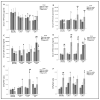Lipopolysaccharide-Induced Delirium-like Behaviour in a Rat Model of Chronic Cerebral Hypoperfusion Is Associated with Increased Indoleamine 2,3-Dioxygenase Expression and Endotoxin Tolerance
- PMID: 37569622
- PMCID: PMC10418785
- DOI: 10.3390/ijms241512248
Lipopolysaccharide-Induced Delirium-like Behaviour in a Rat Model of Chronic Cerebral Hypoperfusion Is Associated with Increased Indoleamine 2,3-Dioxygenase Expression and Endotoxin Tolerance
Abstract
Indoleamine 2,3-dioxygenase (IDO) and the tryptophan-kynurenine pathway (TRP-KP) are upregulated in ageing and could be implicated in the pathogenesis of delirium. This study evaluated the role of IDO/KP in lipopolysaccharide (LPS)-induced delirium in an animal model of chronic cerebral hypoperfusion (CCH), a proposed model for delirium. CCH was induced by a permanent bilateral common carotid artery ligation (BCCAL) in Sprague Dawley rats to trigger chronic neuroinflammation-induced neurodegeneration. Eight weeks after permanent BCCAL, the rats were treated with a single systemic LPS. The rats were divided into three groups: (1) post-BCCAL rats treated with intraperitoneal (i.p.) saline, (2) post-BCCAL rats treated with i.p. LPS 100 μg/kg, and (3) sham-operated rats treated with i.p. LPS 100 μg/kg. Each group consisted of 10 male rats. To elucidate the LPS-induced delirium-like behaviour, natural and learned behaviour changes were assessed by a buried food test (BFT), open field test (OFT), and Y-maze test at 0, 24-, 48-, and 72 h after LPS treatment. Serum was collected after each session of behavioural assessment. The rats were euthanised after the last serum collection, and the hippocampi and cerebral cortex were collected. The TRP-KP neuroactive metabolites were measured in both serum and brain tissues using ELISA. Our data show that LPS treatment in CCH rats was associated with acute, transient, and fluctuated deficits in natural and learned behaviour, consistent with features of delirium. These behaviour deficits were mild compared to the sham-operated rats, which exhibited robust behaviour impairments. Additionally, heightened hippocampal IDO expression in the LPS-treated CCH rats was associated with reduced serum KP activity together with a decrease in the hippocampal quinolinic acid (QA) expression compared to the sham-operated rats, suggested for the presence of endotoxin tolerance through the immunomodulatory activity of IDO in the brain. These data provide new insight into the underlying mechanisms of delirium, and future studies should further explore the role of IDO modulation and its therapeutic potential in delirium.
Keywords: delirium; indoleamine 2,3-dioxygenase; kynurenine pathway; neurodegenerative diseases.
Conflict of interest statement
The authors have no conflicting interests to disclose.
Figures









 ) indicates the development of delirium-like behaviour under LPS treatment in the CCH rats. Abbreviations: IDO: indoleamine 2,3-dioxygenase; TRP: tryptophan; KYN: kynurenine; CCH: chronic cerebral hypoperfusion; GCN2: general control nonderepressible 2; eIF-2α: alpha subunit of eukaryotic initiation factor-2; AhR: aryl hydrocarbon receptor; LPS: lipopolysaccharide; QA: quinolinic acid; KYNA: kynurenic acid.
) indicates the development of delirium-like behaviour under LPS treatment in the CCH rats. Abbreviations: IDO: indoleamine 2,3-dioxygenase; TRP: tryptophan; KYN: kynurenine; CCH: chronic cerebral hypoperfusion; GCN2: general control nonderepressible 2; eIF-2α: alpha subunit of eukaryotic initiation factor-2; AhR: aryl hydrocarbon receptor; LPS: lipopolysaccharide; QA: quinolinic acid; KYNA: kynurenic acid.
References
-
- Gogia B., Fang X. Differentiating Delirium Versus Dementia in the Elderly. StatPearls Publishing; Treasure Island, FL, USA: 2021. - PubMed
-
- Gibb K., Seeley A., Quinn T., Siddiqi N., Shenkin S., Rockwood K., Davis D. The consistent burden in published estimates of delirium occurrence in medical inpatients over four decades: A systematic review and meta-analysis study. Age Ageing. 2020;49:352–360. doi: 10.1093/ageing/afaa040. - DOI - PMC - PubMed
-
- Abate S.M., Checkole Y.A., Mantedafro B., Basu B., Aynalem A.E. Global prevalence and predictors of postoperative delirium among non-cardiac surgical patients: A systematic review and meta-analysis. Int. J. Surg. Open. 2021;32:100334. doi: 10.1016/j.ijso.2021.100334. - DOI
MeSH terms
Substances
Grants and funding
LinkOut - more resources
Full Text Sources
Medical
Research Materials

